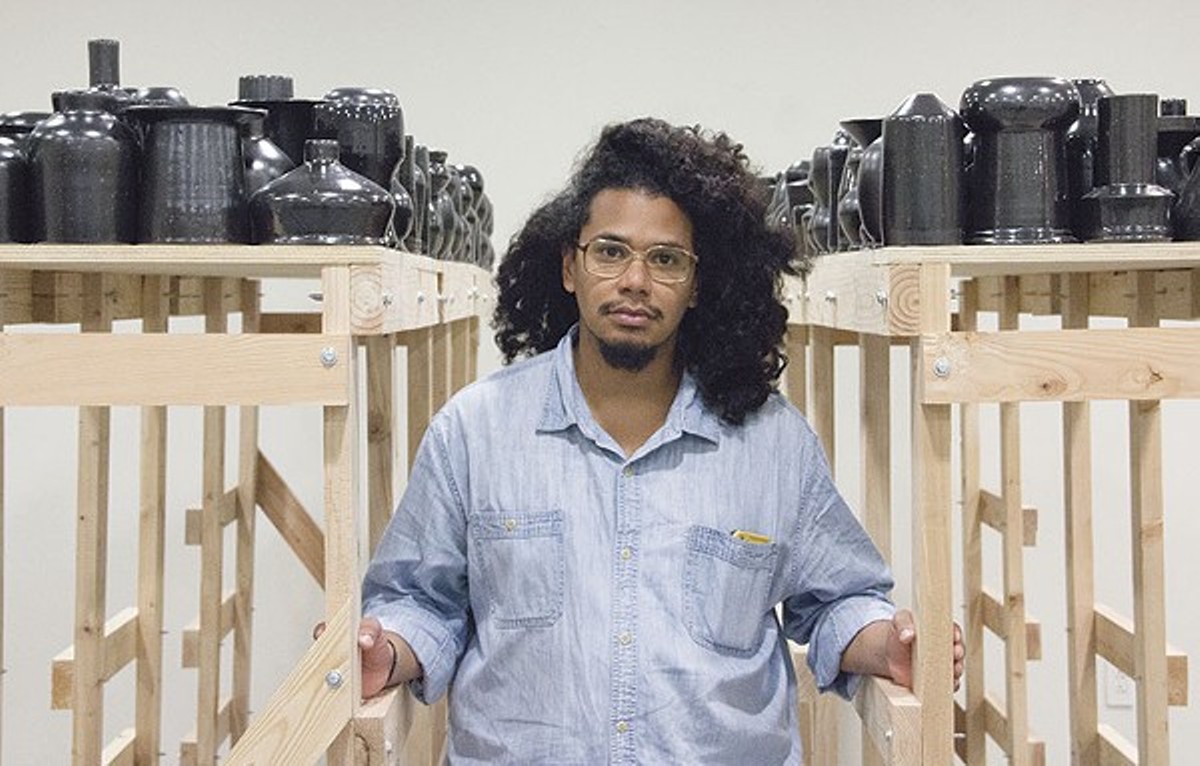In the week of September 19, the 24-year-old sculptor and multimedia artist Kahlil Irving was supposed to be basking in the triumph of his first solo exhibition, scheduled to open the Friday before at the Bruno David Gallery.
Instead, the show was canceled through a frustrating act of God — the unexpected discovery of structural defects temporarily shuttered the building. And then a different kind of development, though no less frustrating, set Irving on a different course.
Just six days after what was supposed to be his gallery debut, he finds himself across the street at the Contemporary Art Museum of St. Louis, arguing that its current exhibition supported white supremacy and needed to be taken down.
Before a 400-strong crowd, with the audience overflowing from the balcony, Irving takes to the mic.
"They knew it was something that would get them their return. That's why this is here," he says to the packed room. Dozens of audience members nod their heads.
Around a corner is the museum's main gallery. There, hanging from one of the towering walls, a floor-to-ceiling photo of a black woman in a bikini makes bedroom eyes over her shoulder. She's been streaked with toothpaste. On the opposite wall, the image of a black protester being mauled by a police dog is obscured behind circular blotches of chocolate.
"Someone wanted a return." Irving continues. "But they're not going to get it this time. Because it's got to go."
Criticizing the museum isn't something Irving does lightly.
Irving first walked into the Contemporary Art Museum of St. Louis as a teenager. It's just a ten-minute walk from Metro Academic and Classical High School, the public school from which he graduated. CAM exposed the precocious Irving to that critical sense of newness that he now seeks in his own art — the cutting edge, the never-before-seen. The kind of creativity that plays in the unexplored boundary between what is and what could be.
But Irving takes art seriously. It's not enough for artists to provoke, he says. They must also remember that their work, no matter how abstract, draws its existence from the world around them.
Now CAM's racially charged museum exhibit has yanked Irving and others into the middle of a controversy they never asked for, one that's left St. Louis grappling with the intersection of art's ephemeral ideals and the inescapable history of black oppression in America.
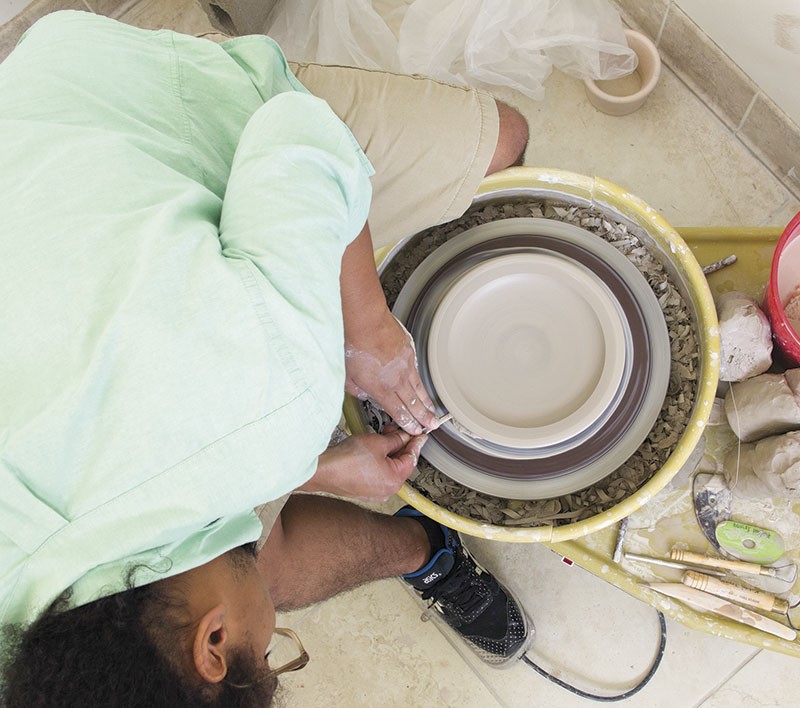
In Kahlil Irving's studio, art begins as earth. He slams a block of clay onto a potter's wheel, working the speed with a foot pedal. The machine's telltale whir fills the network of cubicles and classrooms that stretch through the first floor of Walker Hall on the main campus of Washington University.
It is late afternoon on a weekday in mid-August. Irving, a graduate fellow in the Sam Fox School of Art and Design, is still getting re-acclimated to life in his hometown, having recently returned from a two-month printmaking residency in Venice, Italy. In a matter of days, hordes of college students will fill the air with the bustle of creative industry. Now, though, the hallways and rooms are dead silent, save for the sound of Irving's wheel. He kneads his palms into the sides of the spinning lump, pressing it into an even wedge between his hands.
"I know when I'm in control," he says. "I can tell in my fingers it's where I need it to be."
Irving presses a divot into the undulating clay, and then a cylinder, slicked with water, rises and falls at his whim. He jabs his right index finger about halfway up, forcing the clay to stretch and become the slender, tapered neck of a vase. Using a flat metal tool called a rib, Irving rubs away the drag marks left by his fingers.
Irving holds up the result, a smoothed clay pot shaped somewhat like a squat wine bottle. All it needs now is some time in a hot kiln.
"Yeah. That's one," he says, placing the piece on a shelf. He's done this thousands of times since taking his first pottery classes as a preteen at a local arts nonprofit in Tower Grove Park. Beginning to end, the clay became a pot in about five minutes. He makes it look easy.
"Twelve years, man," he says, laughing. "Twelve years. Out of all the things I can do in my life, I can make a good pot."
Irving was born in San Diego, but in childhood bounced between the custody of his father in St. Louis and his mother, who spent time in Nebraska, Arizona and Colorado. He settled in St. Louis permanently at eleven, and soon after his father took him to the Potter's Workshop, a nonprofit operated by local artist and musician Jenna Bauer.
Even then, she could sense he was something special.
"He had determination, willingness to get on his bike and ride to classes several times a week. He recognized an opportunity and did not let it pass him by," she says.
As Irving entered high school, he transferred that doggedness to building a portfolio, and spent much of his time improving his skills under the instruction of teachers at Craft Alliance. Dan Barnett, the studios manager there, remembers young Kahlil shadowing him at every opportunity. "He was tenacious; he wanted to learn everything."
His work paid off. Irving was one of just four applicants awarded full scholarships to the Kansas City Art Institute in 2010.
In 2012, as an undergrad, Irving attended a benefit auction at Craft Alliance. He'd donated a piece he'd made in Kansas City, a ceramic frame with gold bars protruding from the bottom. Also in attendance that evening was a Washington University ceramics professor, Buzz Spector.
"I met him moments after I bought the piece," says Spector. "Often, when you tell a young artist that you like their work, they have to take it on faith. But I had just forked over cash, so he knew I was sincere."
Irving's work in Kansas City didn't go unnoticed. He applied for and won a flurry of grants, fellowships and international residencies. After graduating, he applied to several top master's programs. He settled on an institutional fellowship (tuition included) as a Chancellor's Graduate Fellow at Washington University.
Spector is now Irving's advisor. It's not just Irving's technical proficiency that stands out, he observes, but the rare thoughtfulness in which Irving places a piece of art in relation to the surrounding environment.
"Not everyone has that ability," Spector says. "He has the seriousness of someone who loves what he does, not the seriousness of someone who only performs curiousness."
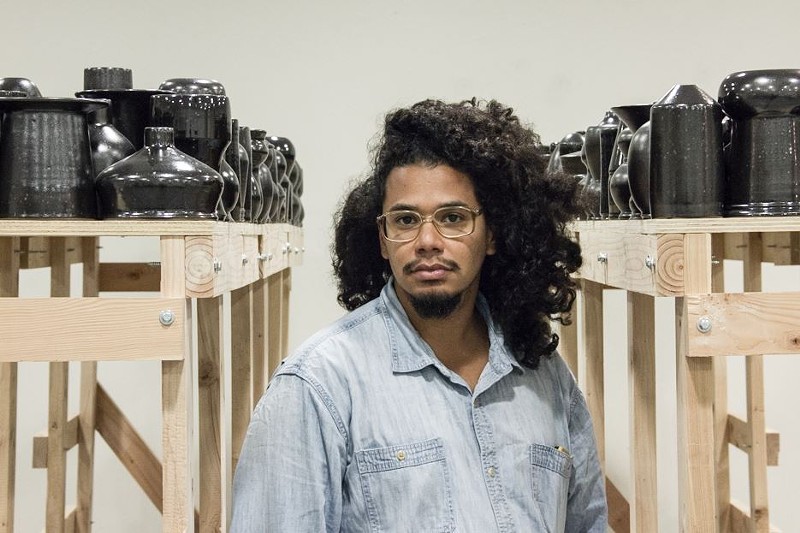
Irving knows racism. During a semester abroad in Hungary, he was spit upon. His hair was pulled. At a bar, a man pulled out a hammer and threatened to use it if Irving didn't get the fuck out of there.
He has no illusions about St. Louis, either. The city is built on a racial history that contaminates its present, a spirit of segregation and slavery. It is a legacy that white people often dismiss as irrelevant. But a Confederate monument still watches over Forest Park. The region's municipalities squeeze poor black residents with court fees. Local police departments struggle to undo decades of abuse that can no longer be hidden behind a badge.
In a classroom near Irving's studio, two wooden platforms sit as testaments to the nature of blackness. The surfaces are raised five feet, around eye level, and support row after row of black clay vessels. Though treated with the same dark glaze, each one is different: Tall and short, angular and bulbous, the shapes evoke salt shakers and urns, decanters and shell casings.
Irving has spent the last year sculpting the pieces, about 400 in all. If you pass through the open corridor between the platforms, the overlapping curves seem to press in from your periphery, creating a kind of tunnel of black-on-black figures.
Above his blocky beige glasses, a cloud of curly hair circles Irving's shoulders. He wears shorts and a baggy denim shirt with the cuffs rolled up.
The installation before him is called "Before and After Sundown, Town," a title intended to draw on the Jim Crow-era reality of racist townships across America, those places where blacks were not welcome — on pain of arrest, beatings or worse — after daylight hours.
Each black vessel, explains Irving, represents the body of a black person. By avoiding humanlike forms, he allowed the work's monumental scale to stand on its own. The piece has layers of meaning. The rows of vessels can be seen as soldiers marching to war or congregations of black families at a park. The vessels, like black people themselves, are visible and vulnerable entities. They are black men and women passing through sundown towns. They are communities rejecting segregation amid an ocean of angry white faces. They are family, witnesses to the persistence of blackness.
"This work is to advance the position that blackness, the reality of black people, will be here in every town in which black people existed," Irving says. That reality doesn't just disappear. As with the rest of America, "No matter where you go in St. Louis, you continuously have to fight with the issue that there are people opposed to blackness existing."
"Before and After Sundown, Town" is part of a series of work called "Undocumented." The series began with just 49 black ceramic vases, a piece called "49er's (Dead Soldiers)." For each subsequent version, Irving added more pieces and updated the name. When he reached 79 black vessels, it became "ConcernedStudent1950: or The Johnson Family Reunion." For the third, Irving crossed two ten-foot-long tables, which he filled with 250 vessels and titled simply "X."
"I'm using a very formal language of shape and form," he says. "In a way I'm celebrating blackness. I'm celebrating form and shape and the vessel, the possibility of containment, and the forms that possibility can take."
The final installment of "Undocumented" was set to be unveiled at the Bruno David Gallery exhibition. Irving planned to mass some 300 vessels on one twenty-foot-long platform in the gallery. He was still trying to come up with a name for the project when, on August 31, he got a call from Bruno David himself.
The news was bad. A routine engineering inspection had turned up structural defects in the rear of the building. Overnight, a gallery that was gearing up for three months of exhibitions was kaput. Condemned.
The canceled show was a bitter disappointment. Irving had invited not only friends and family members, but gallerists, museum curators and art collectors.
He's trying to make the best of it. "Anything can happen, anything can occur at any moment," he says. "I just have to keep a clear head, keep focused on the prize, and keep making the work."
But if he thought the gallery closure meant he'd be lying low for awhile, he was wrong. Just a few weeks later, a controversy erupted at the crossroads where art meets activism, and Irving found himself in the center.
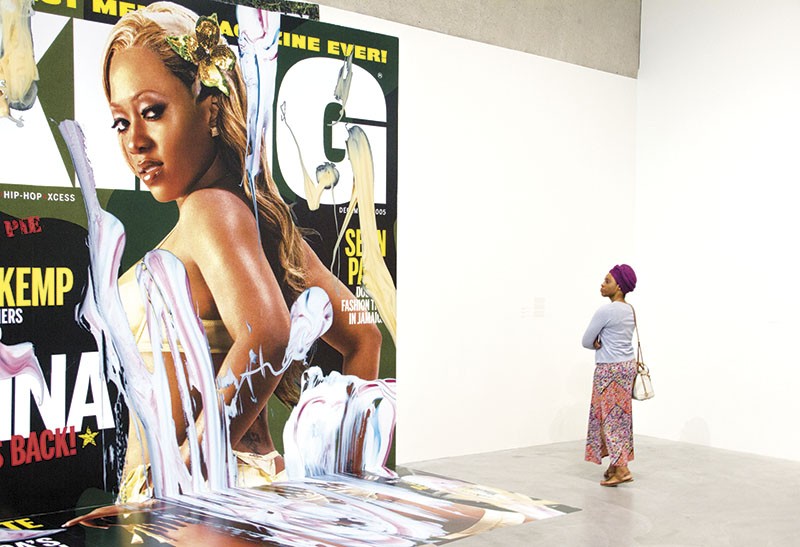
For the Contemporary Art Museum of St. Louis, landing the Kelley Walker retrospective must have initially seemed like quite a coup. The Georgia-born, New York-based artist is known for his multimedia work, said to comment on culture and technology — as well as its provocative use of racial and historical imagery.
Yet when Irving and other black artists saw Walker's work on the museum walls, they were taken aback. The white artist had chosen two pieces that projected what they saw as an incoherent mockery of the black body and the civil rights movement.
One piece, titled, "Aquafresh plus Crest with Whitening Expressions," is an enormous screen print of a KING Magazine cover featuring the rapper and model Trina in a bikini. Walker had added splatters of toothpaste to the cover and digitally processed the result. Trina looked like the victim of a porno money shot.
On the opposite wall, "Black Star Press (rotated 90 degrees)" displays three prints of the same photograph taken during the Birmingham race riots of 1963. The photo had captured a police dog lunging at a young black man during a protest. Walker had blotched and slathered the images with chocolate sauce and printed a digital version of the messy collage.
But while Walker has drawn some criticism for such images, the controversy didn't truly explode until he appeared at CAM for the artist's talk on September 17. According to accounts by Irving and others present, Walker brushed off pointed questions about the meaning behind his racially charged work.
Damon Davis, a local interdisciplinary artist who attended the talk, lit into Walker in a Facebook post the next day.
"If you are an artist and you are making work that is specifically racially and sexually charged, if you use black people for props in your work, then at least be ready to explain yourself," Davis wrote. "This is not art, he is just appropriating the images of us, throwing toothpaste on it and selling it as something original. He couldn't explain his thought process 'cause there was none."
Davis concluded by calling for a boycott of CAM until Walker's pieces were removed. The post was shared more than 500 times, and media coverage followed.
The outrage went deeper than Walker's artwork. His conduct during the artist's talk baffled Irving and others. First, Walker's work had reduced a black woman to a two-dimensional prop, and now he expected a St. Louis audience — a black audience, at that — to mull it quietly and go home? Did he really think his chocolate-covered civil rights photos would elicit respectful murmurings, and nothing more?
It didn't take long for Davis' call for boycott to gain momentum. An already-scheduled panel discussion on Walker's work was quickly expanded to include eight black St. Louis artists, including Irving.
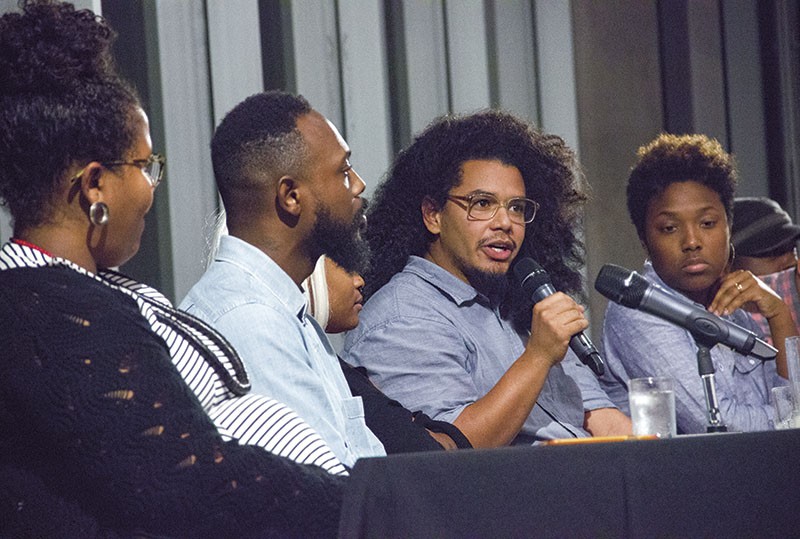
On September 22, hundreds pour into the museum to listen to the panel. They pause by Walker's pieces, peering at the terse descriptions that offer little more than artspeak and fluff.
Walker, it should be noted, was not invited. Davis, acting on his threat of boycott, offers his moral support but declines to attend.
"The fact that this rates as being OK for curation is more than problematic," photographer Kat Reynolds says, kicking things off with an introductory statement. "I felt uncared for, as a black artist in this city."
Her words are echoed by other artists on the panel. They are hurt and conflicted about the role the museum was playing. In the past, CAM had served a critical function in the arts community and provided resources and education that benefitted black artists in the city. But the museum was standing behind Walker, even praising him. Curator Jeffrey Uslip had even called Walker "the one contemporary artist of our generation that is thinking through history, race, identity, and their lasting evolving and rotating implications."
Irving is still bristling over Uslip's comments.
"That pisses me off," Irving says when the microphone comes his way. He offers a list of black artists who more than meet the same description — and they, he says, have the courage to explain the convictions behind their art work. The same can't be said of Walker.
The work should be taken down, Irving says.
"Keeping it up says that if you support this work, you support white supremacy and a white man being able to do whatever he wants without question," he says. "And we're questioning it right now."
But Irving, for all his forcefulness, also struck a conciliatory note. After coming to this museum for years, he believes it is a bright node in the art galaxy of St. Louis.
"We don't want to alienate. We don't want to hate," he tells the audience. "We want change. Don't hate the space. Hate the decision."
The panel discussion and audience Q&A stretches on for more than two hours. That same day, three museum employees send a letter to the museum's senior administrators demanding Uslip's resignation, the removal of Walker's offensive artwork and for reforms to be implemented in the museum's curatorial process.
On September 23, Walker releases an apology through his New York City gallery, though it does little to explain the racial elements in his work. He doesn't attempt to answer the questions raised during the panel discussion. He writes that the use of black bodies was part of his mission to create thoughtful and "sometimes difficult" dialogues about social equality and civil rights.
"I have always hoped that these works, and the exhibition as a whole, would provide a forum for a conversation about the way American society gets represented in the media as images shift from context to context (newspapers, magazines, film, TV, etc.) and about how the representation of the body, particularly of the black body, is an exceedingly complex topic in American art and culture," he writes. "I hope that the St. Louis community will give my exhibition a chance to generate this conversation."
Four days after the panel, the museum's administration comes to a decision. It takes a middle ground, one which does not involve Uslip's resignation. Walker's works will remain, but a wall now partially conceals the work from visitors entering the museum. At the gallery's entrances, signs have been placed with a warning: "This gallery contains content that may be difficult for some viewers."
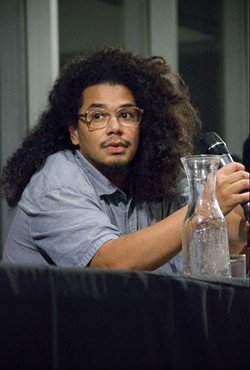
The day after the panel, in a Delmar Boulevard coffee shop, Tina Turner belts out the chorus to "Private Dancer" as Irving doodles absentmindedly on a notepad.
"I'm not into controversy," he says with a sigh. For Irving and other black artists, this is a depressing and exhaustingly familiar story of a white man who got what he wanted. Walker has staked his position, and the museum has chosen to stay in bed with him.
"I still support the museum, but there are things that have to be addressed, actions that the museum has to be willing to take on," he says. "If you let people do what they want to do, and not be accountable for anything, that's a continuation of imperialism on a micro-level. That's not right."
Irving's own work attempts to puncture that imperialism with form and context. And even as an undergraduate in Kansas City or a sculptor making pots in a basement studio in Washington University, he's had to defend his work.
The next year will determine the next step in Irving's life an artist. Despite the setback, the Bruno David Gallery says the exhibition will debut sometime soon, in a new location, meaning Irving can finally complete the "Undocumented" series. He is already toying with ideas for his next big project. After putting so much effort into the installation, it feels strange to be facing a blank page again. It's been years since he created anything in the human form, and he's been musing about its relationship to race, history and urban environments. Sometimes he sits at the pottery wheel, empties his mind and just lets the ideas turn.
Irving leaves the coffee shop and walks toward the Lewis Center, an offshoot studio space belonging to Washington University.
As he walks back to his studio, Irving spots two discarded lottery tickets on the sidewalk in front of a book store. In a previous work, he collected lottery tickets and other street trash and used them as decal decorations on ceramic sculptures. He picks the lottery tickets off the ground — he doesn't have these in his collection.
There's a mantra which Irving returns to in conversation. Art is life. Life is art.
"I say that, so people recognize what they're doing," he explains. It's a way of encouraging honesty, in himself and others. It's a matter of attentiveness to history and humanity alike.
He's not sure what he'll do with the scratched-off lottery tickets. He doesn't have a plan yet. But he carefully slips them into a notebook. You never know. Life has a funny way of turning to art, and sooner rather than later.
Follow Danny Wicentowski on Twitter at @D_Towski. E-mail the author at [email protected]

